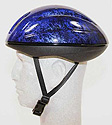Neuroscience For Kids
 Educating Brains about Helmet Use
Educating Brains about Helmet Use
November 21,
2012
You've probably heard it a thousand times: "Put on your helmet!" We know that wearing bicycle helmets reduces that chance of a head injury, but do educational programs increase the use of helmets? A study by researchers at Georgia Health Science University suggests that programs that include a discussion about brain function and anatomy do promote helmet use in children.
In the new study, the research team divided children (5-18 years old) into a control group and an intervention group. Children in the control group each received a bicycle helmet and bicycle safety educational materials. Children in the intervention group also received a helmet and the education materials, but they also attended a special 30-45 minute session that included:
- Discussion of basic brain function with information about the senses, decision making, thinking and hormones.
- Discussion of basic brain anatomy using brain and skull models.
- Demonstration showing how the brain and an egg are similar.
- Demonstration showing a Jell-O brain mold.
- Simulation of a brain injury.
- Demonstration of the proper way to wear a helmet.


Prior to the experiment, only about one-third of the children owned a helmet. Of the 58 students in the intervention group, only 5.2% wore a helmet every time they rode a bike; only 12.9% of the 62 children in the control group wore a helmet every time they rode a bike. Adults were not very good role models: the children reported that when they rode bikes with adults, only 6.6% of the adults wore helmets.
One month after the education program, the researchers asked the children about their use of bike helmets. In the control group, 82.8% of children reported that they wore their helmets every time they rode their bikes; in the intervention group, 92.6% of the children reported that they wore their helmets every time they rode their bikes. The researchers also followed up with the children three months after the education program and found a small reported decrease in helmet use by children in the control group (80.0%) and a small reported increase in helmet use (96.2%) by children in the intervention group.
This study demonstrates that just a brief education program can promote the use of helmets. Sure, you have to own a helmet to use it in the first place, but extra discussion about the brain seems to encourage children to wear their helmets for a longer time.
Reference and further information:
- Barnes, V.A., Maria, B.L., Caldwell, A.L. and Hopkins, I., Prevention of traumatic brain injury in youth and adolescents, Journal of Child Neurology, 10.1177/0883073812464272, 2012.
- Helmet Use - Kids vs. Parents - Neuroscience for Kids
- Helmet Injuries on the Increase - Neuroscience for Kids
- Police Enforcement of Helmet Laws 1 - Neuroscience for Kids
- Police Enforcement of Helmet Laws 2 - Neuroscience for Kids
Copyright © 1996-2012, Eric H. Chudler, University of Washington
